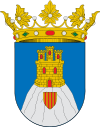Maluenda
| Maluenda municipality | ||
|---|---|---|
 Maluenda - townscape with castle hill
|
||
| coat of arms | Map of Spain | |

|
|
|
| Basic data | ||
| Autonomous Community : |
|
|
| Province : | Zaragoza | |
| Comarca : | Calatayud | |
| Coordinates | 41 ° 16 ′ N , 1 ° 37 ′ E | |
| Height : | 581 msnm | |
| Area : | 40.09 km² | |
| Residents : | 922 (Jan. 1, 2019) | |
| Population density : | 23 inhabitants / km² | |
| Postal code : | 50340 | |
| Municipality number ( INE ): | 50159 | |
| administration | ||
| Website : | Maluenda | |
Maluenda is a place and a municipality ( municipio ) with 922 inhabitants (as of 2019) in the province of Saragossa of the autonomous community of Aragon .
location
The place Maluenda is located on the Río Jiloca in western Aragon at an altitude of about 580 to 600 m above sea level. d. M. about 90 km (driving distance) southwest of Saragossa and only about 8 km south of Calatayud .
Population development
| year | 1960 | 1970 | 1981 | 1991 | 2001 | 2008 |
| Residents | 1543 | 1405 | 1196 | 1031 | 1001 | 1095 |
In the 19th century the population of the place was mostly over 1,000 people; in the first half of the 20th century it rose to a maximum of 1,900 people. Due to the increasing mechanization of agriculture , the number of inhabitants has steadily declined since then.
economy
Agriculture has been the livelihood of the community since it was founded; the place itself acted as a center for trade, crafts and services of all kinds.
history
Small stone and bronze age finds were made in the municipality ; Iberian or Celtiberian finds are missing, however. Numerous coin finds ( denarii ) date from Roman times ; the presence of the Visigoths is not documented. In the 8th century, Arab-Moorish armies conquered almost all of northern Spain; In the 10th century, an outpost of the Caliphate of Córdoba was built on the castle rock , which after its collapse (1031) was also claimed by the Taifa Kingdom of Saragossa.
In 1120 Alfonso I reconquered Maluenda for the Christians ( reconquista ), but the west of Aragon was also interesting for the ever-expanding Castile , so that there were numerous conflicts over its political and economic affiliation. In 1363 the castle and town were temporarily taken by Castilian troops. The three imposing churches were built in the 15th century and bear witness to the town's heyday. In 1845 the politician Pascual Madoz counted 150 badly built houses and 100 simple cave dwellings in Maluenda ; He also mentions the cultivation of wheat, barley, wine, hemp and vegetables as well as a factory for the production of coarse paper , which was needed for the production of sacks etc., and two grain mills.
Attractions
- The parish church of the village, dedicated to the Assumption of Mary , is a Mudejar building made of mostly plastered bricks; only the imposing bell tower shows a rich architectural ornamentation. The south side of the church was extended in the 15th or 16th century by an arcade-supported vestibule, the wooden ceiling ( alfarje ) of which was previously painted - remains of the paintings are still preserved. Behind the late Gothic portal decorated with stone masks is another room with a wooden ceiling, the floral and geometric paintings of which are still well preserved; An Arabic inscription can also be seen - apart from that, the entire room as well as the wall surfaces and vaulting of the actual nave are provided with joint paintings.
- The church of Santa Justa y Santa Rufina , built on a hill in the early 15th century, is dedicated to the two early Christian Sevillian saints Justa and Rufina , who were quite popular in medieval and early modern Spain. The rather unadorned west facade has two small bell towers; Below the eaves of the nave runs a battlement, which can also be seen as an architectural design element. The interior, painted in a similar way to the church of Santa María with decorative joints, houses an imposing altarpiece from around 1475 with scenes from the vitae of the two saints.
- The church of San Miguel , dedicated to the Archangel Michael , is in ruin.
- The same goes for the castle on the rock. Only the Torre Albarana , which was probably formerly part of the castle, is - after a restoration at the beginning of the 21st century - in good condition.
Web links
- Maluenda, sights - photos + information (Spanish)
Individual evidence
- ↑ Cifras oficiales de población resultantes de la revisión del Padrón municipal a 1 de enero . Population statistics from the Instituto Nacional de Estadística (population update).




